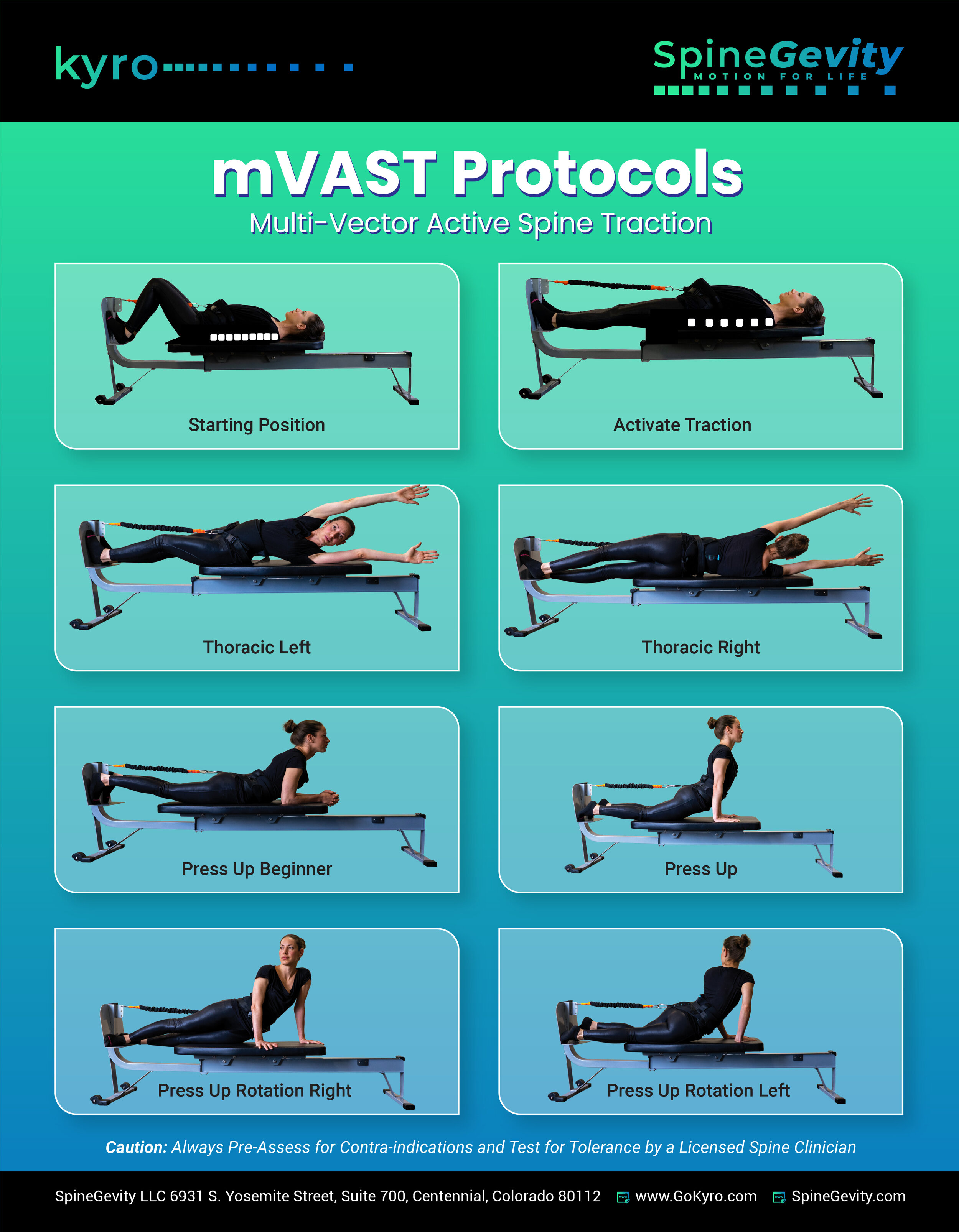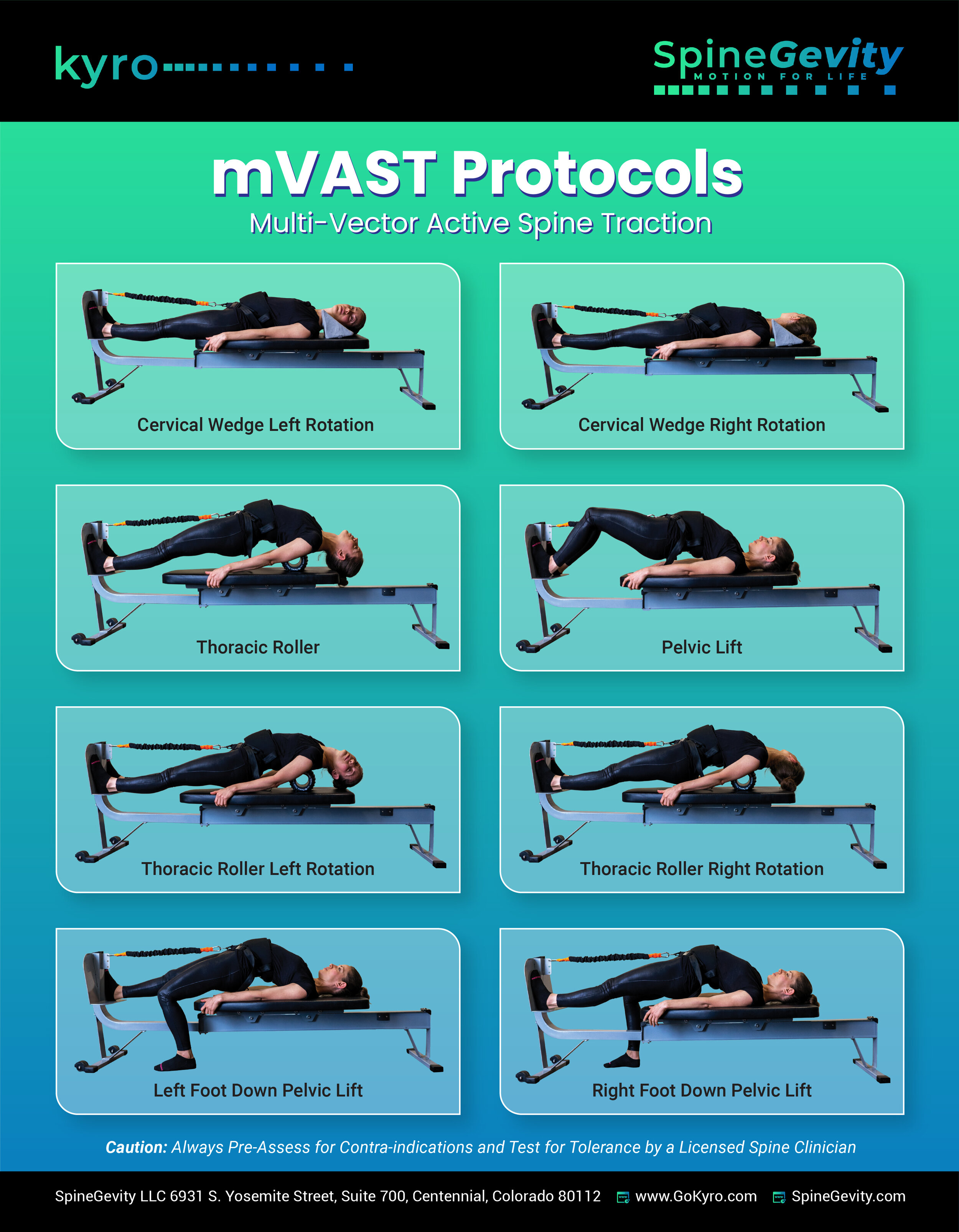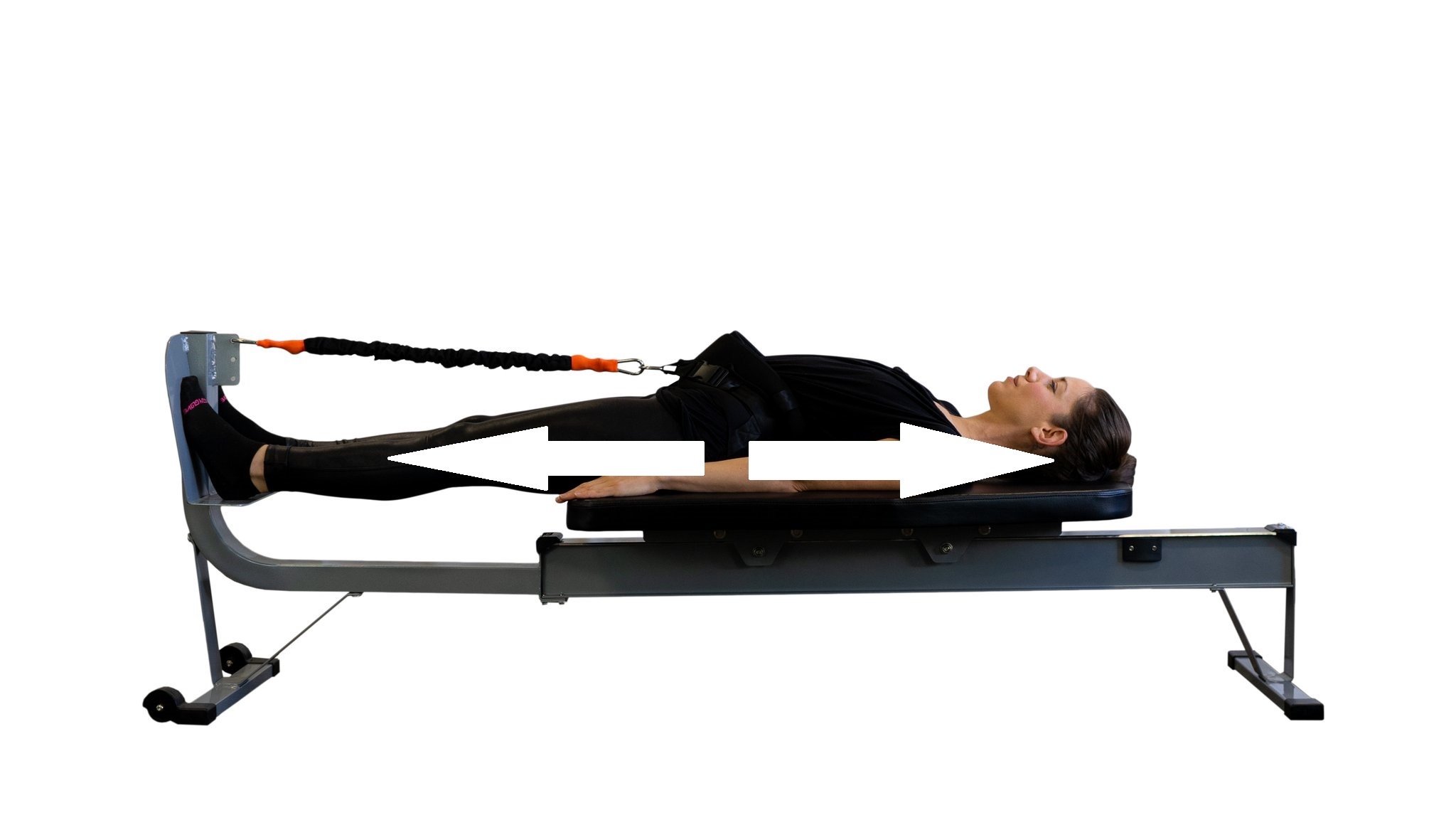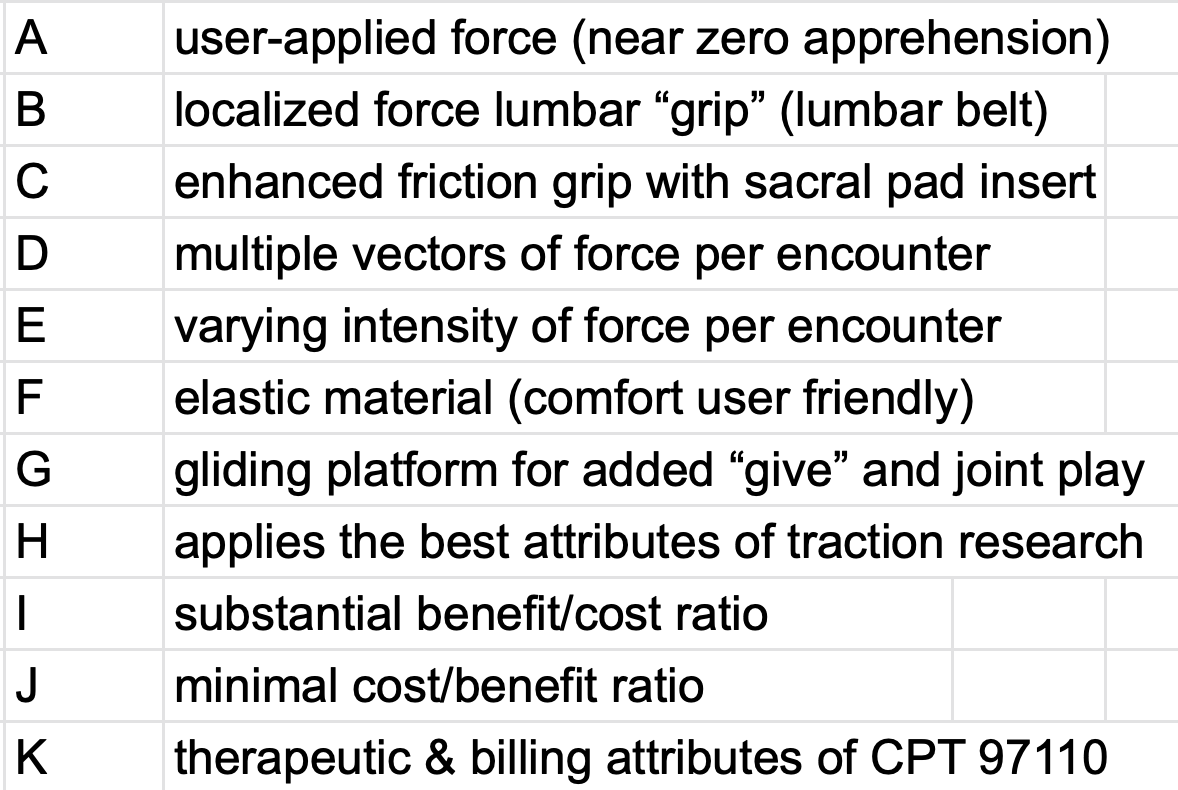What is mVAST?
What is mVAST?
What is mVAST (multi-vector active spine traction)?
All Decompression Systems induce an opposing force. The question is, which is the most effective, safest, and most comfortable for the user?
When most people hear the phrase "core strength" they think mostly of muscle strength and really do not consider the other components necessary for complete stability. However our true core strength comes from healthy function and structural integrity of many inter-dependent anatomical and physiological components. We will first identify key components, and then describe the application and physiological effects of Multi-Vector Active Spine Traction (mVAST).
SoloTrac is a non-surgical, drug-free procedure for patients suffering discogenic pain caused by:
Bulging disc
Herniated disc (non-fragmented)
Degenerative disc disease (mild to moderate)
Posterior Facet syndrome
Sciatica
Post-surgical patients (those without hardware installed)
Spinal Stenosis (mild to moderate)
Non-specified mechanical low back, thoracic, or neck pain
M.ulti-V.ector
One of the key attributes of the mVAST platform is the ability to apply localized force along multiple vectors and multiple angles in a single session. Motorized systems can adjust the angle of applied force, however, this can only be added after an average unit of time typically lasting a minimum of 45 minutes. Additional units of time would be required in order to add additional force vectors in a given encounter, thus extending the patient visit well over 1 hour in duration. mVAST sessions, however, can easily achieve application of multiple vectors of traction force in a single 20-25 minute encounter. Clinicians appreciate this added value of cost-efficiency and cost-effectiveness. The flat bed surface allows the user to be placed in multiple varying positions in order to change vector angle, based on patient comfort and clinical indication.
A.ctive
User generated leg press exertion causes the bed to glide away from the foot of the table. Squats are the most basic and universally accepted form of exercise designed to strengthen the lower extremities and related lumbopelvic “core stabilizer” muscles. This is, therefore, an active form of therapy with all the benefits of exercise while reclined on a gliding bed, and recognized by research to be therapeutically superior to passive forms of therapy.
Calming Patient Apprehension: Instead of electric motors, our platform harnesses force generated by simple leg press muscle exertion. This resolves the problem of patient apprehension and guarded muscle tension as people naturally tend to relax when they are given control of force intensity. We use a simple strain gauge to measure and display the force being applied. Other systems that are large, high tech, and powered by electric motors, are more likely to trigger "lab coat" anxiety, apprehension, and guarded muscle tension.
Multiple cycles of careful back-and-forth gliding motion vs. constant sustained tension: Published medical research has investigated the therapeutic effect of “milking” the spine as compared to a constant pulling tension. mVAST produces a repetitive stretch of spinal tissue, and activates hydraulic flow effect of spinal fluid. Hydration and nutrients flow in upon unloading, followed by waste byproducts flowing out upon reloading. When applied repetitively, this is analogous to a hydraulic pump. Physiological fluid imbibition helps repair and sustain tissue integrity of the intervertebral disc, vertebral body, endplates, and articular pillar.
Elastic tension vs non-elastic cable tension: Spinal shock absorption efficiency is maximized when the spine functions like a resilient coil spring. The use of elastic bungee material is more “forgiving” compared to motorized systems utilizing a non-elastic steel cable. Patients report a firm, but comfortable “stretchy” sensation produced by bungee material as opposed to a steel cable which some patients describe as more of a forceful tug from the motorized wench. The elastic and resilient quality with the mVAST platform is key to achieving a gratifying patient encounter.
S.pine
The key to achieving effective therapeutic opposing force is grip and localization.
The mVAST lumbar belt is designed to concentrate and direct traction force specifically targeting and anchoring the lumbar spine. A small triangular shaped cushion called the “lumbosacral pad” is affixed to the lumbar belt. This optional component enhances friction, concentrated directly against the spinal lamina and articular pillar. This simple add-on component increases effective unloading, vertebrae separation/decompression by approximately 20% to 35%. This force multiplier is analogous to a wine bottle cork screw with a leverage handle, designed to press into the edge of the bottle lip in order to concentrate effective lifting force. The simple force multiplier can now employ leverage to pop the cork out of the bottle using a small fraction of physical effort.
T.raction (Decompression)
In simple terms, traction produces an opposing force. When an opposing force is applied to a physical object, this has a decompression effect. Some products claim to produce “true” decompression based on research demonstrating evidence of this physical effect. However, the physiologic effects of traction is universally true any time an opposing force is achieved. For example, inversion therapy engages gravity to produce some degree of traction by anchoring the lower extremities. The prime difference to consider is the degree to which a physiological decompression effect is localized to spinal structures by opposing force tension, modulated by physical factors such as friction, grip, and force vector. Traction and decompression can, therefore, be considered synonymous.
Attributes Compared to Passive Motorized Decompression
A resilient spine responds better with elastic tension applied along multiple vectors.. Expensive decompression systems only apply a single non-elastic vector of force during each encounter, thus minimizing the number of embedded pain-source fibers released per encounter.
Comparing to Electric Motorized Machines
mVAST is "active" and therefore billable as 97110 and reimbursed by insurance as an active therapy compared to “passive” traction procedure codes, typically not covered by insurance.
Apprehension vs relaxed: The user is relaxed and comfortable as therapeutic tension is self-applied. What is a Golgi Tendon Organ Reflex? Whenever muscles are severely overstretched, the human body might suddenly go into a protective “lockdown” mode. This means the muscles will temporarily shut down in order to avoid an overstretch injury. Our Technique is Designed to NEVER activate this reflex. In fact, we have found that user-applied force is 95% less sensitive to this reflex compared to large machines powered by an electric motor. Also, there is virtually zero “White Coat Syndrome,” nervousness, or emotional apprehension with a user-applied force.
Complexity compared to motorized decompression systems.
SoloTrac is a simple, intuitive, and practical tool that helps achieve better and faster results, with less complexity. There are no electric motors or computers on board. We use a basic digital load cell to measure force intensity.
Cost Compared to Motorized Decompression Systems
Because SoloTrac is a basic gliding platform, not requiring a computer or electric motor and, therefore, 90% less expensive. The cost savings can then be passed on to you, the health care consumer.
Doctors talked. We Listened.
We have surveyed a wide variety of clinicians who specialize in non-surgical management of chronic pain.
Achieving better outcomes means you become the preferred specialist in your town. This gives you a substantial advantage in a competitive spine care marketplace
Needs to achieve faster results Needs to have concise set of easy-to-follow procedures Needs to be profitable (insurance billable as 97110)Needs to be portable and easily store away to save space
Needs to be affordable
Needs to compliment all other forms of treatment
Must be science & evidence based (clinical trial completed)
At What Stage is SoloTrac Most Effective?
Our platform is not designed to treat conditions of active traumatic injury, acute inflammation, disc fragmentation, or severe pathology. We try to catch the condition in the earlier stage of the degenerative process. Our protocols are designed to minimize bone and tissue deformation - while maximizing release of tissue adhesions, fixations, and scar tissue. If we can safely apply the right combination of stretching and motion, this provides a better chance of improving function that is lasting and supports our goals for health capacity and life expectancy.
Case History, Exam, Imaging, Decompression and MLS
What problems does it solve?
Faster results for difficult cases. Applies multiple angles in a single encounter increasing the likelihood of neutralizing pain-source lesions
User friendly and intuitive
Billable as an active therapy 97110
Portable and storable (small footprint)
Patients love it - no more apprehension or anxiety as with motorized systems
Load force is easily measured for safety and documentation
90% Less Expensive compared to high tech motorized spine decompression systems
Designed for Clinicians Specializing in Spine Care and Pain Management
mVAST protocols will compliment all other forms of therapy and improve your outcomes, no matter what you do.
Attributes Compared to Flexion Distraction Therapy
Just as flexion distraction began in 1973 as a simple table that bends up and down, our mVAST platform is also starting as a basic platform, but one that glides along a track - and with more emphasis of traction force along the X axis. Just as advanced flexion distraction tables utilize force plates and sensors to measure force, our device utilizes a load cell to measure force. We test each patient for tolerance at the most gentle intensity before increasing force incrementally over time.
Gentle, Effective chiropractic techniques since 1984.


A Thorough Case History and Examination, combined with chiro care, MLS cold laser, and spine decompression gets the best and fastest results.
A Recipe for Spine Longevity
-Grip the Spine; Localize and Anchor to create a true opposing force; Apply stretching force gently. Clinical correlation is essential before force vector is initiated.
-Key Attributes for Comfort and Safety: 1. Elastic Resistance Material (Bungee). 2. Gliding Track
Cautions and Contra-Indications: Severe Stenosis. , Severe Disc Herniation, fragmentation, or extrusion/sequestration, advanced osteoporosis, space occupying lesion, severe bone spurs/osteophytes/syndesmophytes, spine/pelvis pathology or instability, cancer, tumors, infection
SoloTrac is Designed to Compliment chiropractic SMT (spine manipulation therapy), Spine Rehabilitation, and/or Physical Therapy protocols
You ARE NOT a candidate for SoloTrac if you have:
Instabilities of the spine, such as recent fractures
Bilateral pars defects
Gross osteoporosis
Cancers or tumors of the spine
Surgical hardware fixation (pins, screws, rods, etc…) in the region of the spine being targeted.
Pregnancy
Abdominal irregularities, pathology, calcified abdominal aorta, or obesity. Lumbar belt must not compromise circulation or normal physiology
Patients under the age of 15
Pelvic defects, fractures, dysplasia. or other irregularities
Disc fragmentation, calcification, severe arthritis and any surgical spinal appliances are absolute contraindications.











